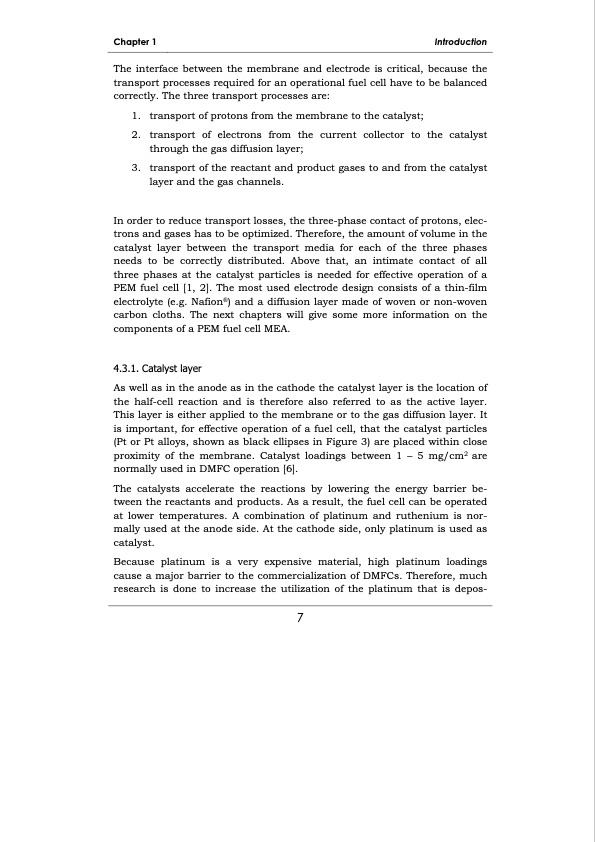
PDF Publication Title:
Text from PDF Page: 015
Chapter 1 Introduction The interface between the membrane and electrode is critical, because the transport processes required for an operational fuel cell have to be balanced correctly. The three transport processes are: 1. transport of protons from the membrane to the catalyst; 2. transport of electrons from the current collector to the catalyst through the gas diffusion layer; 3. transport of the reactant and product gases to and from the catalyst layer and the gas channels. In order to reduce transport losses, the three-phase contact of protons, elec- trons and gases has to be optimized. Therefore, the amount of volume in the catalyst layer between the transport media for each of the three phases needs to be correctly distributed. Above that, an intimate contact of all three phases at the catalyst particles is needed for effective operation of a PEM fuel cell [1, 2]. The most used electrode design consists of a thin-film electrolyte (e.g. Nafion®) and a diffusion layer made of woven or non-woven carbon cloths. The next chapters will give some more information on the components of a PEM fuel cell MEA. 4.3.1. Catalyst layer As well as in the anode as in the cathode the catalyst layer is the location of the half-cell reaction and is therefore also referred to as the active layer. This layer is either applied to the membrane or to the gas diffusion layer. It is important, for effective operation of a fuel cell, that the catalyst particles (Pt or Pt alloys, shown as black ellipses in Figure 3) are placed within close proximity of the membrane. Catalyst loadings between 1 – 5 mg/cm2 are normally used in DMFC operation [6]. The catalysts accelerate the reactions by lowering the energy barrier be- tween the reactants and products. As a result, the fuel cell can be operated at lower temperatures. A combination of platinum and ruthenium is nor- mally used at the anode side. At the cathode side, only platinum is used as catalyst. Because platinum is a very expensive material, high platinum loadings cause a major barrier to the commercialization of DMFCs. Therefore, much research is done to increase the utilization of the platinum that is depos- 7PDF Image | Development of membrane materials for direct methanol fuel cells

PDF Search Title:
Development of membrane materials for direct methanol fuel cellsOriginal File Name Searched:
thesis_H_Yildirim.pdfDIY PDF Search: Google It | Yahoo | Bing
NFT (Non Fungible Token): Buy our tech, design, development or system NFT and become part of our tech NFT network... More Info
IT XR Project Redstone NFT Available for Sale: NFT for high tech turbine design with one part 3D printed counter-rotating energy turbine. Be part of the future with this NFT. Can be bought and sold but only one design NFT exists. Royalties go to the developer (Infinity) to keep enhancing design and applications... More Info
Infinity Turbine IT XR Project Redstone Design: NFT for sale... NFT for high tech turbine design with one part 3D printed counter-rotating energy turbine. Includes all rights to this turbine design, including license for Fluid Handling Block I and II for the turbine assembly and housing. The NFT includes the blueprints (cad/cam), revenue streams, and all future development of the IT XR Project Redstone... More Info
Infinity Turbine ROT Radial Outflow Turbine 24 Design and Worldwide Rights: NFT for sale... NFT for the ROT 24 energy turbine. Be part of the future with this NFT. This design can be bought and sold but only one design NFT exists. You may manufacture the unit, or get the revenues from its sale from Infinity Turbine. Royalties go to the developer (Infinity) to keep enhancing design and applications... More Info
Infinity Supercritical CO2 10 Liter Extractor Design and Worldwide Rights: The Infinity Supercritical 10L CO2 extractor is for botanical oil extraction, which is rich in terpenes and can produce shelf ready full spectrum oil. With over 5 years of development, this industry leader mature extractor machine has been sold since 2015 and is part of many profitable businesses. The process can also be used for electrowinning, e-waste recycling, and lithium battery recycling, gold mining electronic wastes, precious metals. CO2 can also be used in a reverse fuel cell with nafion to make a gas-to-liquids fuel, such as methanol, ethanol and butanol or ethylene. Supercritical CO2 has also been used for treating nafion to make it more effective catalyst. This NFT is for the purchase of worldwide rights which includes the design. More Info
NFT (Non Fungible Token): Buy our tech, design, development or system NFT and become part of our tech NFT network... More Info
Infinity Turbine Products: Special for this month, any plans are $10,000 for complete Cad/Cam blueprints. License is for one build. Try before you buy a production license. May pay by Bitcoin or other Crypto. Products Page... More Info
| CONTACT TEL: 608-238-6001 Email: greg@infinityturbine.com | RSS | AMP |